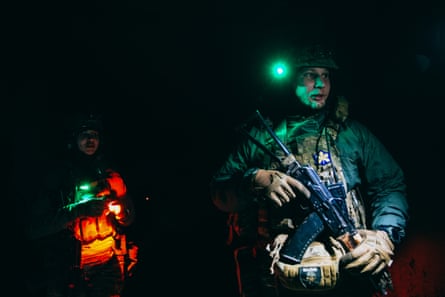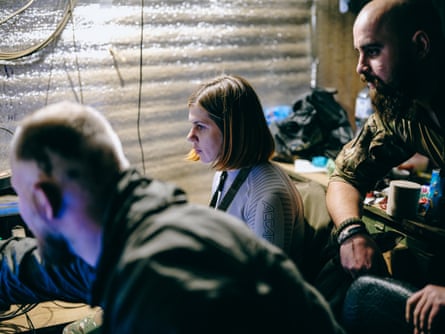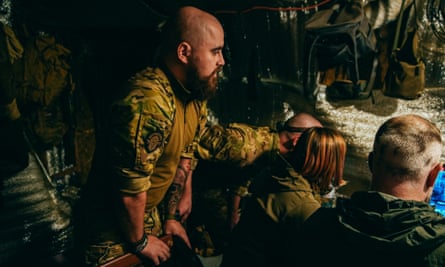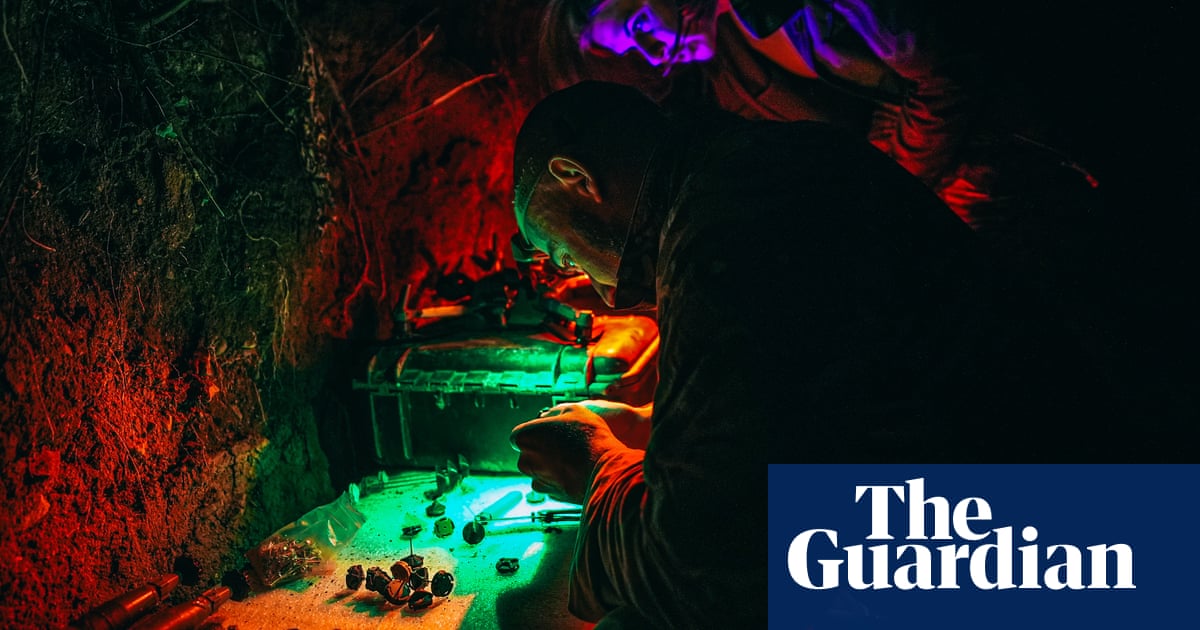The armoured car’s bumpy high-speed journey comes to a halt, and the Guardian team are dropped off in the November darkness, where two Ukrainians soldiers await. Using hard to detect red and green torchlight, they follow an unmarked trail across rough fields, punctuated by the sounds of frontline shelling, until a concealed opening appears. Inside, a specialist drone crew is at work.
Nearby, a drone flight of a few minutes away, is the frontline Donetsk town of Toretsk, where the Russian invaders have been gaining territory using surges of infantry and ceaseless artillery. Underground in the surprisingly warm bunker is a team of four Ukrainians, all members of the Khyzhak Brigade of police officers turned soldiers.
 View image in fullscreen
View image in fullscreen
To reward its best drone squads, Ukraine’s military introduced a points system in June. To an outsider it appears chilling: points are scored for Russian soldiers recorded killed or wounded and for tanks, guns and other equipment destroyed. In return, new drones are on offer per point scored.
Luiza, a brigade spokesperson, says for every Russian soldier wounded, four points are added – if they are “eliminated” it is six. If a Russian 152mm artillery piece is destroyed it is 40 points and half that if the weaponry is simply damaged. “Collected points can be exchanged for drones,” she adds, so an FPV (first person view) drone is available for “one to three points depending on the functionality”. This is considered by the brigade as a boon when so many drones in the Ukrainian army are paid for by soldiers or via fundraising through family and friends.
But in the bunker it is not a game – the deadly threat in the background is one reminder that it is too serious for that. The drone squad’s primary goal would always be to halt the remorseless Russian advance, though in Toretsk, and across the eastern front, the battlefield situation for Ukraine remains fraught.
 View image in fullscreen
View image in fullscreen
Rostik, 31, is the unit commander and a police officer who previously worked in the central city of Dnipro. The bunker, he says, is the eighth position since June, each one further back than the one before. The withdrawal amounts to “seven kilometres”, a figure he obtains by picking up a small handheld device with a live war map, on which every building and intersection is marked with a number. He draws a ruler to calculate the territory lost.
Tonight, the team in the bunker are launching armed Mavic 3 drones with thermal cameras. They arm the drones with small bombs before one member of the unit heads into the chilly night to release them for takeoff. Other squads are running reconnaissance – hunting for targets – their video feeds shared while periodically the mobiles used for group communication chatter into life.
In the bunker, the thermal imaging is revealing. Heat sources can be detected hundreds of metres away. In the early evening, 7pm to 8pm, the drone is sent up repeatedly. It flies at about 60km/h (37mph) – meaning no person can outrun it – though for now the goal is to drop a bomb through a hole in a building where Russian soldiers are believed to be hiding. As the drones fly into Toretsk, outlines of buildings appear and stray dogs can be seen running out, as pointed out by one of the team members.
 View image in fullscreen
View image in fullscreen
Iryna, 32, was a police officer in Lviv, until a few months ago; now she is one of a growing number of women volunteering to fight. Her husband was already in the military, and she had become frustrated by living in the largely peaceful western city without contributing, she says. “My husband was against this, but there was a moment when I realised that what if I joined up and killed at least two Russians? Maybe it means my husband is going to come back earlier?” she adds.
To join up, however, Iryna lied – telling her husband she was responding to a forced summons. “I don’t remember what exactly he said in reply, but I remember that I told him: ‘Hold on. You could complain about this. We could fight on this. Or you could help me to prepare the gear.’”
A drone mission lasts about 15 to 20 minutes, before the craft is brought back for a battery change. Soon it becomes possible to identify some landmarks, notably the slag heaps, by which the pilots must fly. We stay the entire night watching, though for the crew a shift lasts three days, minimising the risk of trips in and out.
 View image in fullscreen
View image in fullscreen
Soon after 1am, another team has news. They have found a person patrolling or walking alone – a target. Andrii, a burly man with a love of American football, is at the controls while Iryna sits alongside. Soon he finds a glowing white figure walking along a road or path. Allowing for the wind, he drops a bomb from 140 metres; it bends towards its target, exploding, he says, “three meters away”. The person falls at the side of the road, apparently collapsed.
By now the team of four are crowded around the screen, attentive and mostly silent. Andrii then drops a second bomb – a standard tactic. The team cheer, though it is impossible not to be shocked. Later, when asking Andrii how he felt when he appeared to kill, he looks surprised at the question and instead expresses satisfaction at completing the task.
skip past newsletter promotionSign up to This is Europe
The most pressing stories and debates for Europeans – from identity to economics to the environment
after newsletter promotion
This is a war fought in battles of ones and twos via drones and screens, as often as with guns and mortars. “Obviously it is easier to kill from drones, not with small arms,” Rostik says, “but we are attacking them because otherwise they will attack our infantry or make our life worse somehow.” In Toretsk, Russian forces press forward most nights, relying heavily on infantry, typically in waves of five, going from building to building – used, Rostik says, by their commanders as “biomass”.
 View image in fullscreen
View image in fullscreen
The team decide to drop a third bomb, with Iryna at the controls. Then they begin the task of documentation to ensure the incident is verified and their points score updated. Iryna records a clip from the drone feed to be shared to a brigade Telegram group for review.
It is not the busiest night. Often the pace slackens, and there is a chance for conversation and food. Volodya, 32, also a police officer from Lviv, heats up chicken, rice and vegetables on a gas stove, washed down with cans of the Ukrainian Non Stop energy drink. Because the base is connected to the internet via Starlink, the one critical piece of US technology in the dugout, calls can be made. Soon after we arrive, Rostik, talks to his wife and two sons. “I speak to them five six times a day,” he says. And so his military call sign is Aliona, his wife’s name.
The background shelling is constant, though only once does the earth shake. “Only a person who is mentally not healthy is not afraid of dying,” says Rostik. Russian armed drones track the “road of death” to Toretsk, though Iryna says the team takes “all necessary measures” to protect themselves, including “praying vigorously”.
 View image in fullscreen
View image in fullscreen
The real fear comes from Russian one tonne glide bombs – partly guided air-launched munitions that Ukraine cannot counter. At the unit’s central command, they can observe Su-30 and Su-34s jets as they approach, and track a missile once launched. All they can do is give soldiers around 90 seconds’ warning. The bunker would not survive a direct hit.
The US election concluded a week earlier, and it is time to ask what they would say if Donald Trump was present. “I guess if he reached this place, he would understand everything,” Andrii says. So what about potentially losing US support at a time when the war is already difficult? “We have no other way to go,” Rostik says. “We are fighting for our country, for our families, for our kids, those we have lost; for those who were killed, who were raped, who were tortured. That’s our land, and that’s the fight we have. We don’t care who is going to be the US president.”
Eventually it is time to leave, across the open ground while it is still dark, feeling more vulnerable than on the way in, not least because the heat signatures of the group could be visible to a Russian drone operator. In the armoured car pickup, the driver has a song on high volume prepared as we speed away: AC/DC’s Highway to Hell. The journey is mercifully to safety.
The Ukrainians, however, face unceasing Russian aggression and acknowledge that the desire to guarantee their independence means an end to the war may be not be close, whatever Trump tries. Tired after nearly three years of fighting, it is not an attractive thought. When might there be peace again? “The scariest thing is we make our kids inherit this war,” Rostik replies.
∎